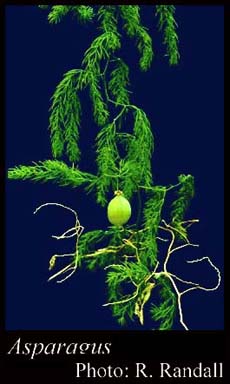- Reference
- Sp.Pl. [Linnaeus] 1:313 (1753)
- Name Status
- Current







Scientific Description
Common name. Asparagus. Family Asparagaceae.
Sometimes included in Liliaceae. Includes Myrsiphyllum and Protasparagus.
Habit and leaf form. Shrubs (1), or lianas (2), or herbs, or herbaceous climbers (2). Switch-plants; with the principal photosynthesizing function transferred to stems; solitary or clustered cladodes or phylloclades. Leaves much reduced (persistent bracteate scales that subtend the cladodes). Annual, or perennial. Leaves cauline. Plants with neither basal nor terminal concentrations of leaves; rhizomatous, or tuberous. Rhizome and root tissues not red-pigmented. Self supporting, or climbing; the climbers stem twiners. Twining anticlockwise. Stem growth not conspicuously sympodial. Leaves fasciculate; alternate (solitary); membranous (scales); sessile; more or less sheathing; simple. Leaf blades entire; parallel-veined. Leaves without stipules. Vernation not circinnate. Leaf anatomy. Hairs present, or absent. Extra-floral nectaries absent. Stem anatomy. Secondary thickening absent. Roots. Roots with velamen (often), or without velamen.
Reproductive type, pollination. Fertile flowers hermaphrodite, or functionally male and functionally female, or functionally male, or functionally female, or hermaphrodite, functionally male, and functionally female. Unisexual flowers present, or absent. Plants hermaphrodite, or monoecious, or dioecious (rarely), or polygamomonoecious. Female flowers with staminodes. Pollination mechanism unspecialized.
Inflorescence and flower features. Flowers solitary, or aggregated in ‘inflorescences’; in racemes, or in fascicles (or clusters). The terminal inflorescence unit probably cymose. Inflorescences terminal, or axillary; umbel-like or racemelike, but probably always determinate?; not pseudanthial; espatheate. Flowers pedicellate (articulate); bracteate; ebracteolate; small; regular; 3 merous; cyclic. Perigone tube present, or absent. Hypogynous disk absent. Perianth of ‘tepals’; 6; 2 -whorled; isomerous; free, or joined; sepaloid, or petaloid; without spots; similar in the two whorls; green, or white, or yellow. Androecium present (even in functionally female flowers). Fertile stamens present, or absent (in female flowers). Androecial members definite in number. Androecium 6. Androecial sequence determinable. Androecial members adnate (at the base of the perianth); all equal; free of one another; 2 -whorled. Androecium exclusively of fertile stamens (in male and hermaphrodite flowers). Stamens 6; all more or less similar in shape; diplostemonous; filantherous. Filaments appendiculate (spurred at the base), or not appendiculate. Anthers dorsifixed, or basifixed; versatile; dehiscing via longitudinal slits; introrse. Pollen shed as single grains. Fertile gynoecium present, or absent (in male flowers). Gynoecium 3 carpelled. The pistil 3 celled. Carpels isomerous with the perianth. Gynoecium syncarpous; synstylovarious to eu-syncarpous; superior. Ovary plurilocular; 3 locular; sessile. Gynoecium stylate. Styles 1; apical; shorter than the ovary at anthesis to about as long as the ovary at anthesis. Stigmas 1; 3 - lobed (sometimes minutely); capitate. Placentation axile. Ovules 2–12 per locule; non-arillate; hemianatropous, or anatropous, or orthotropous.
Fruit and seed features. Fruit fleshy; indehiscent; a berry; 1–50 seeded. Seeds endospermic. Endosperm oily. Embryo well differentiated. Cotyledons 1. Embryo straight, or curved. Testa encrusted with phytomelan, or without phytomelan.
Geography, cytology, number of species. World distribution: widespread, especially Old World. About 370 species. A genus of about 370 species; 6 species in Western Australia; only 1 native species.
Economic uses, etc. Cultivated ornamentals, and culinary asparagus (A. officinalis).
Etymology. From the Greek (asparagos) and Latin (asparagus) names of the plant.
Taxonomic Literature
- Wheeler, Judy; Marchant, Neville; Lewington, Margaret; Graham, Lorraine 2002. Flora of the south west, Bunbury, Augusta, Denmark. Volume 1, introduction, keys, ferns to monocotyledons. Australian Biological Resources Study.. Canberra..
- Wheeler, J. R.; Rye, B. L.; Koch, B. L.; Wilson, A. J. G.; Western Australian Herbarium 1992. Flora of the Kimberley region. Western Australian Herbarium.. Como, W.A..